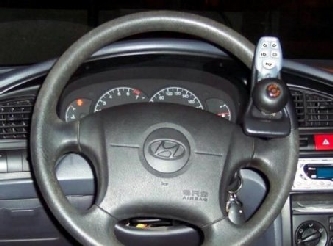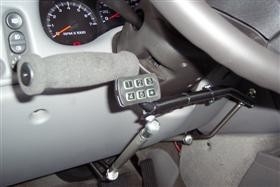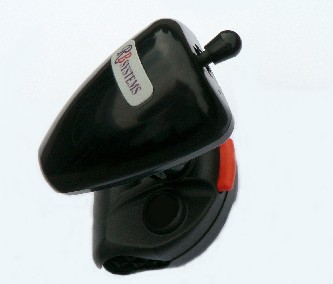Short Description
A driving aid which is installed into a vehicle to enable the driver to program and operate up to six functions on the car (such as headlights, indicators, horn and wipers) without removing their hands from the steering wheel. The unit is suitable for most vehicle types. Several models are available.
Models
The Signaller is installed (hard wired) on the hand operated brake / accelerator controls. It has a keypad with 6 push button symbols indicating the function of each button.
The Wireless Radio Frequency Selector Keypad is installed 'close to hand' on the Steering wheel or to a wheel Spinner Knob. This has a five symbol, six function ability.
* RB-6K Standard car KEYPAD. 6 buttons / 6 functions keypad relay interface.
* RB-6RF Standard car Wireless RF REMOTE. 5 buttons / 6 functions relay interface
* B-7K or RB-9K Full CAN BUS interface KEYPAD (Computerised Vehicles) 6 buttons / 6 functions keypad signaller kit.
* RB-7RF or RB-9RF Full CAN BUS interface RF REMOTE.
* (Computerised Vehicles)
The RB 7 and RB9 are units configured for computerised vehicles like Volkswagen, Audi etc (European). The 7 or 9 is used depending on the vehicle type.
Ask the installer / supplier to confirm which type is needed for your car. The K and the RF is the distinction between the hard wired keypad (K), fitted to the hand control; and the steering wheel model (RF, radio frequency, not wires).
More Details
* The Signaller unit is made of plastic with rubber push buttons.
* The units six functions are: Turn (R/L) signals, Horn, Lights (high/low beam), front window wipers, and rear wipers. All or any combination of these can be activated according to individual clients requirements.
* The six push buttons display icons to indicate which item is being activated and feature back lighting which illuminates when the buttons are turned on.
* The Signaller's Selector Keypad lights up automatically with other interior gauges for night driving.
* The unit can be mounted onto a spinner bracket with the Signaller placed at the 10 or 12 o'clock position.
* The unit is secured to the steering wheel column by a cylindrical strap that has a platform that the Signaller is secured to.
* The Signaller may be fitted on a steering wheel with additional modified driving controls, such as spinner knobs. Alternatively it can be fitted onto a modified hand control or a foot control system that requires the driver to use a lever system to accelerate and brake the vehicle.
* The Signaller can receive commands from any other driving aid (e.g. headrest buttons) and can also activate a radio provided the unit is wired through to the steering wheel.
* It is also compatible with CAN-BUS electrical systems and most computerised vehicles (e.g. new models of Audi, Citroen and Volkswagon).
* All existing vehicle controls remain dominant, which means that if a driver without a disability uses the vehicle, their activation of the lights, wipers, indicators and other functions will override the Signaller. The signals will not automatically cancel while the brake is applied. There is a time delay of 10 - 15 seconds that can be programmed into the unit. This allows for accidental pressing of a button before the action is completed.
Factors To Consider
The Signaller is designed to increase driver safety because all six functions such as indicating for turning, or activating the horn etc are achieved from the one convenient location.
Installation
* The product must be installed by an authorised agent.
* Installation can be performed onsite by a mobile installer either before or after a vehicle requires further modifications.
* The Keypad can be installed on existing disability hardware (i.e. accelerator / brake hand controls), or on the steering wheel. The functions of the keypad are activated easily by using only the one finger, thus maintaining driver control of the steering and hand controls at all times.
* The modifications must be certified by the Roads and Traffic Authority.
Place Of Manufacture
Israel
Licence & Insurance Requirements
The RTA requires evidence that the safety standards originally built into the vehicle have been maintained. Therefore, the modifications must be certified by an "Engineering Signatory" who is recognised by the RTA for this purpose. If the modifications are satisfactory, the signatory will issue an "Engineering Certificate" which must be presented to the RTA. The RTA maintains a list of "Engineering Signatories".





 subscribers
subscribers 






